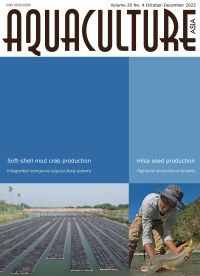Conducting artificial fertilisation, hatching and spawn development of Indian shad, Tenualosa ilisha: Pathfinding hilsa domestication
3 November 2022 | D.N. Chattopadhyay, A. Chakraborty, P.K. Roy, R.N. Mandal, A. Das, A. Hussan, S. Adhikari, B.R. Pillai and S.K. Swain | 408 Downloads | .pdf | 1.37 MB | Freshwater finfish, Hatchery and nursery, India
Hilsa (Tenualosa ilisha) is highly favoured as a food fish by consumers but has a complex life cycle and has proven very difficult to breed. Domestication of hilsa requires extra effort while nurturing the larval stage, which is very sensitive and susceptible to mortality.
This article describes standardised protocols developed by the Kalyani Field Station of the ICAR-CIFA Regional Research Centre, Rahara, for artificial fertilisation, incubation and larval rearing of hilsa, as the first steps towards the goal of hilsa domestication and culture.
Creative Commons Attribution.

